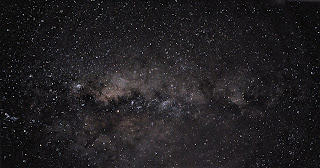One aspect of my astrophotography adventures that I am not entirely satisfied with is processing images.
I am using Star Tools for processing my images.I always feel and know I can do better. So I watched a video tutorial by the creator of Star Tools Ivo Jager.
I then tried to apply some of the techniques he explains.
I also have a far better understanding of the modules and some of the tweaks you can make to each.
So I re-processed my Tarantula image I took in Underberg on a recent vacation.
And here is the result, below that is the previous attempt.
In my opinion this is a much improved version.
The dust and gas from the Large Magellanic cloud shows up much better now!
Sunday, 9 October 2016
Saturday, 1 October 2016
Milky Way from a urban backyard.
I had always figured that capturing any semblance of the Milky way from a light polluted urban backyard was going to be a uphill battle.
After much research trying to figure out ISO settings etc. I took the camera out one clear night and started with a few test shots.
Turns out it was much simpler than I had first thought.
After much trial and error I had a few frames that I stacked in DSS along with some dark frames.
The focus was the hardest part and required many test exposures and adjustments of the focus(manually) until I felt I had it close enough.
The details of the shoot:
14 X 25 second exposures.
13 Dark frames.
The light frames were a mix of ISO 800 and 1600.
Focal length 18.0
Lens was a kit 18-55mm lens.
All of this on a static tripod.
The image was heavily cropped to cut out the neighbours roof and a few other obstructions.
So here is proof that a milky way shot is possible despite intense light pollution.
Why not put your camera on a tripod and give it a whirl?
Here is my peek at the heart of our Galaxy!
And also a annotated version.
After much research trying to figure out ISO settings etc. I took the camera out one clear night and started with a few test shots.
Turns out it was much simpler than I had first thought.
After much trial and error I had a few frames that I stacked in DSS along with some dark frames.
The focus was the hardest part and required many test exposures and adjustments of the focus(manually) until I felt I had it close enough.
The details of the shoot:
14 X 25 second exposures.
13 Dark frames.
The light frames were a mix of ISO 800 and 1600.
Focal length 18.0
Lens was a kit 18-55mm lens.
All of this on a static tripod.
The image was heavily cropped to cut out the neighbours roof and a few other obstructions.
So here is proof that a milky way shot is possible despite intense light pollution.
Why not put your camera on a tripod and give it a whirl?
Here is my peek at the heart of our Galaxy!
And also a annotated version.
Subscribe to:
Comments (Atom)



